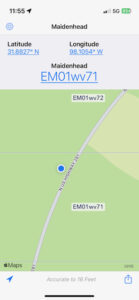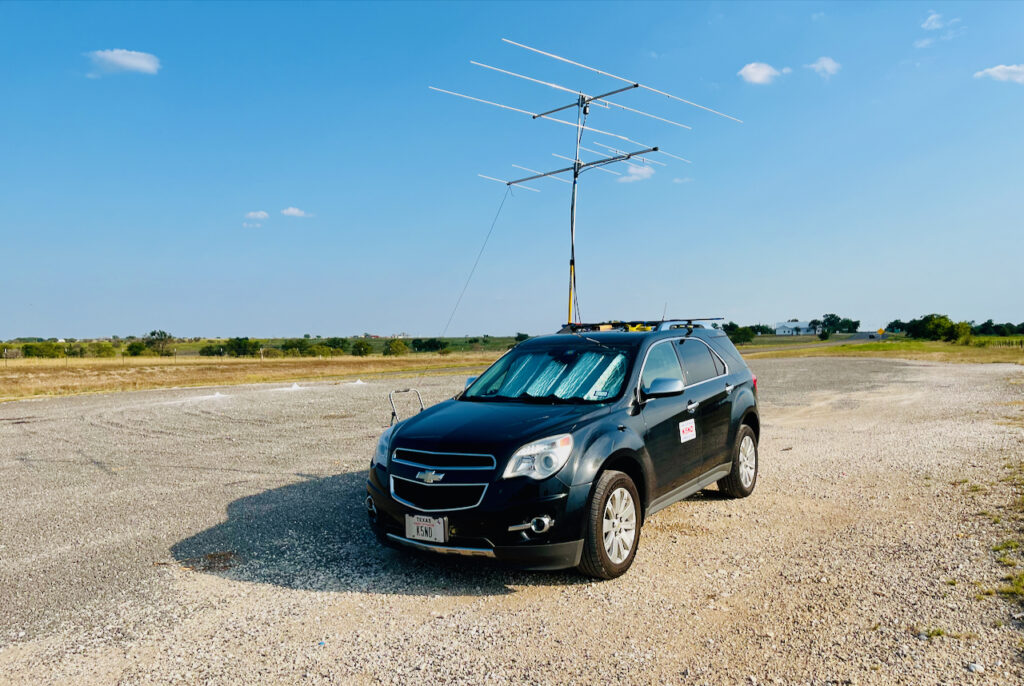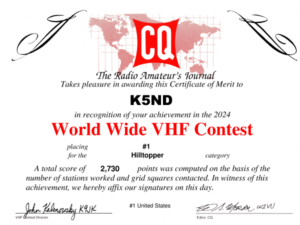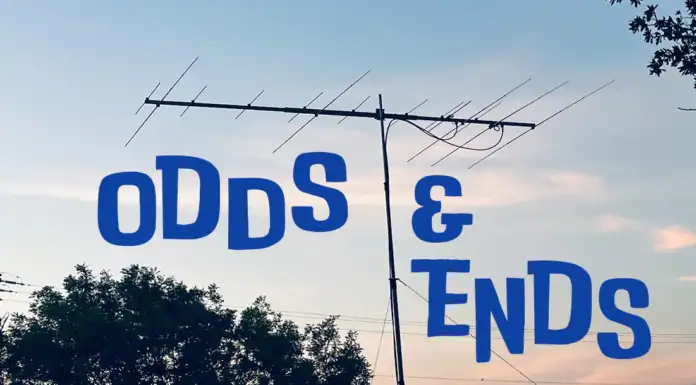I’ve been considering entering a VHF contest in the QRP/portable categories for quite some time. The challenge with the ARRL contests is that Single Operator Portable is a full 33-hour contest entry. And it typically requires lots of bands to get a reasonable score. That approach isn’t all that attractive here in North Texas.
However, the CQ VHF Contest has a Hilltopper category that can operate for a maximum of 6 hours continuously. The challenge is choosing the best six hours. Plus, it is limited to 6 and 2 meters. Here’s the story of my first VHF Hilltopper adventure.
Overcoming Inertia Through Simplification
I recently ran a rover operation from my daughter’s ranch in DM85. For that effort, I needed to cut back on the equipment to still pack all our clothes into the car for our week-long visit. That helped me recognize that I was still capable of simplification!
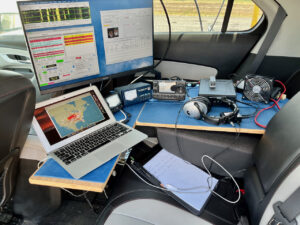 For my Hilltopper adventure, I used the same MacBook Air to run MacLoggerDX and WSJT-X. Once at home, I imported the Mac’s adi file to N3FJP’s VHF Contest Logger to determine the score and generate a Cabrillo file.
For my Hilltopper adventure, I used the same MacBook Air to run MacLoggerDX and WSJT-X. Once at home, I imported the Mac’s adi file to N3FJP’s VHF Contest Logger to determine the score and generate a Cabrillo file.
For a radio, instead of the IC-746PRO, I opted for the IC-7100, which provided a small footprint and was quite capable of producing a 10-watt power level on both bands. Plus, it has an excellent USB cable interface to the laptop.
I also used the same painter pole mast used in DM85. This time, I loaded the mast with the 3-element M2 Yagi for 6 meters and the 5-element Directive Systems Rover Yagi for 2 meters. I have a home-built bracket system and some guy lines if needed.
VHF Operations — Location is Everything
I operated from a favorite rover spot in EM01, just south of Hico, Texas. While it’s not a massive hilltop, it does offer a low horizon in all directions. Plus, it is somewhat mid-way between Austin and Dallas-Fort Worth. It can also reach San Antonio and Houston. Not only that, but there are very few VHF operators from EM01. I felt that all that would make it a great place, even though it’s a two-hour drive from home.
My VHF Hilltopper Results
I chose to operate the contest from the opening, Saturday 1800 UTC/1 PM Local, to 7 PM local, the maximum six hours of continuous operation. I got very lucky that there was quite a bit of activity from Es to the east. That was not expected since the previous week had been completely dead.
I got on FT8, verified the power levels, and started putting QSOs in the log. Every once in a while, I’d check on 2 meters. I’d also point the antenna in a different direction when needed. I was amazed at how well my 10 watts and 3-element were doing on 6 meters. Check out the PSK reporter map.
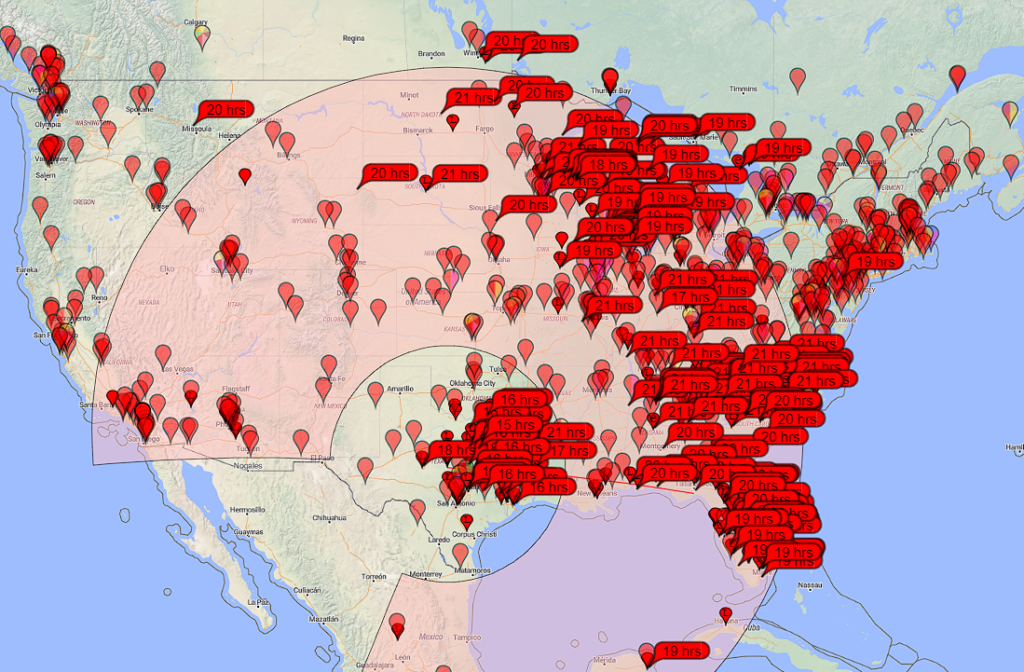
I opted to run using the call sign K5ND/P. I did this primarily because I hoped to operate from home at K5ND on Sunday. Plus, the CQ VHF Contest director told me that it would work just fine to separate the stations and provide more contest activity. However, it did cause some confusion with the log submission process, as it would only allow me to submit as DX, no doubt because of the /P in my call sign.
Around 4:30 PM local time, the activity level started to drop as the Es moved on. I still managed to get a few more QSOs in the log, but by 6:30 PM local time, I packed up and headed home.
Here are my results, all on FT8:
- 6 meters = 62 QSOs and 38 Grids
- 2 meters = 6 QSOs and 4 Grids
- Score = 3,108
I did bring along a microphone and key, but didn’t put them to use. Perhaps I should have when the activity level was reasonably high at the beginning of the contest.
Operating Challenges
WSJT-X gave me a bit of trouble. I had a station call me after what I thought was a completed QSO. I clicked on his call and sent 73 a few times. But, for some reason, his call remained in TX5 for several later QSOs. That, of course, confused other operators to no end. Thankfully, I found it and restarted WJST, which fixed the issue.
I also had several contacts that just could not get my RR73 and repeatedly sent the R. I’m not sure if that was a decoding problem or, more likely, that my signal was very, very weak. Then, some would insist on wanting a number for a signal report. I managed to work through that challenge.
I’m sure that log-checking will resolve those issues, resulting in a few QSOs and grids lost in the process. Dang.
VHF Hilltopper — Fun Times
I’m always pursuing the contest entry category that fits my interests and my station and offers a better-than-average opportunity to finish higher in the rankings. I’ve done this quite a few times with CW and RTTY contests, using QRP power levels and often choosing a single band. This time, I was able to work that out with QRP entry into a VHF contest. We’ll see how my ranking comes out.
I hope that will not only provide you insight into my adventures but also offer some thoughts on how you can get involved in VHF or HF contesting. Good luck.
Update January 2025
The CQ WW VHF 2024 Contest results were published today. I won the USA Hilltopper category, and I placed second in the World and North America. Here’s the certificate. Plus, they sent me a plaque! Probably the only one I’ll ever see in my ham radio contesting life.

